Basketball
Snapshots - 10
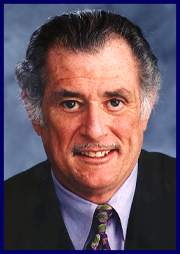
Frank Deford
|
The following story appeared in Sports Illustrated October 11, 1976 in the article "Nobody Loves the Ruling Class" by Frank Deford. It was paraphrased in Steve Riach's book Amazing But True Sports Stories (2004).
Alex George of Kansas City is a retired official who worked 10 bowl games and six NCAA basketball tournaments. About 20 years ago, he officiated a game between Detroit and Wichita. Detroit, down one point with four seconds to go, had the ball out of bounds. Wichita's arena was then in a tough part of the town, and a lot of the fans had been drinking. George watched one Detroit player throw the ball in to another, who shot. At that moment George looked up and saw that a Wichita fan had thrown an overcoat over the basket. The ball hit the coat and the gun went off. "I was working with Cliff Ogden, but the call was mine." George says. "'What are you going to call it, Alex?' he asked me. I told him, 'It's 120 feet to our dressing room, and I'm not going to call it anything until we both get to the door.' When we got there I called it a basket. "A friend of mine named Joe Peters waited for me outside. We didn't come out for a long time and when we did, Joe said he'd carry my bag to the car. We started off and a woman walked up and looked at Joe and said, 'You worked a beautiful game all right,' and then she began beating him with her umbrella. Joe started to point at me, but before he could say anything, I said, 'That's right, you did work a beautiful game.' After all, he'd already been hit. There was no sense for me to get beaten, too."
A great story. But did it actually happen?
- On February 20, 1956, Detroit and Wichita played a one-point game. But several facts don't mesh with George's account.
- The game was played at Detroit, not Wichita.
- Wichita won the game 85-84.
- So George could be recalling that game, but have the teams reversed. After all, there were and are many parts of Detroit that are "tough." But here's the report on the game from United Press as carried in the Holland (MI) Evening Sentinel.
Wichita spoiled Detroit's last Missouri Valley Conference game of the season by nicking the Titans, 85-84, at Detroit. Neither team ever was more than four points apart from the other in the tightly-played contest. The lead changed hands 11 times and the score was knotted 23 times. Both clubs fouled repeatedly in the final minutes and Wichita's accuracy from the line made the difference. Bill Ebben sank 30 points for Detroit for high point honors while Joe Stevens and Bob Hodgson each scored 24 for Wichita. The defeat gave the Titans a 3-9 record for the season. It was Wichita's fifth win in nine games.
- No mention of a last-second shot or an overcoat over the rim. And you'd think that a Michigan paper would include such details for a game played within that state. Even the Hutchinson Herald in Wichita's home state makes no mention of any weird ending to the game during the following days.
Conclusion: Referee George may well have officiated a game in which an overcoat was thrown over the rim. Something so weird would certainly stick in your memory. But the incident didn't happen in a Wichita-Detroit game or, if it did, it wasn't at the end of the game on the deciding shot. It's possible the overcoat basket occurred earlier in the game, and the hometown fans were upset when it turned out to make the difference in the contest.
|
|
"World Champions" before the NBA
From 1939-1948, the Chicago Herald American sponsored an invitational tournament for professional basketball teams.
- Many of the 12-16 teams that competed each year played in various leagues in the northeast section of the country.
- Others were touring teams, usually composed of black players.
- A distinctive feature of the tournament was the inclusion of both white and black teams. As such, the competition lived up to its billing as the "World Professional Basketball championship."
|
Tournament Finals Results
- 1939 New York Rens 34 Oshkosh All-Stars 25
- 1940 Harlem Globetrotters 31 Chicago Bruins 29
- 1941 Detroit Eagles 39 Oshkosh All-Stars 37
- 1942 Oshkosh All-Stars 43 Detroit Eagles 41
- 1943 Washington Bears 43 Oshkosh All-Stars 31
- 1944 Fort Wayne Zollner Pistons 50 Brooklyn Eagles 33
- 1945 Fort Wayne Zollner Pistons 78 Dayton Acmes 52
- 1946 Fort Wayne Zollner Pistons 73 Oshkosh All-Stars 57
- 1947 Indianapolis Kautskys 62 Toledo Jeeps 47
- 1948 Minneapolis Lakers 75 New York Rens 71
|
|
Tournament MVPs
- 1939 Puggy Bell, New York Rens
- 1940 Sonny Boswell, Harlem Globetrotters
- 1941 Buddy Jeannette, Detroit Eagles
- 1942 Ed Riska, Oshkosh All-Stars
- 1943 Curly Armstrong, Fort Wayne Zollner Pistons
- 1944 Bobby McDermott, Fort Wayne Zollner Pistons
- 1945 Buddy Jeannette, Fort Wayne Zollner Pistons
- 1946 George Mikan, Chicago American Gears
- 1947 Julie Rivlin, Toledo Jeeps
- 1948 George Mikan, Minneapolis Lakers
|
-
The New York Renaissance were a team of black players who, like the Harlem Globetrotters (founded 1927) traveled across the country playing all comers from 1923 until 1948.
- The Oshkosh (WI) All-Stars played in the National Basketball League, a forerunner to the NBA. from 1937 to 1948. Their most notable player was Alex Hannum, who played in the NBA from 1949-1957 and also coached in the NBA and ABA. He led the St. Louis Hawks to the NBA Championship over the Celtics in 1958 and guided the San Francisco Warriors to the NBA finals in 1964.
- The Harlem Globetrotters were, and still are, the most famous touring black pro team in history. Like the Rens, the Trotters began at a time when black players were not allowed on white pro teams.
- The Chicago Bruins played in the National Basketball League (1939-42). They were owned and coached by George Halas of the Chicago Bears.
- The Detroit Eagles, managed by Dutch Dehnert, one of Original Celtics, played in the NBL 1939-41, then barnstormed for a year before folding when most of the roster was drafted. One of their players was Press Maravich, father of Pete.
- The Washington Bears were an all-black team that included a number of players from the New York Rens. They posted a 41-0 record in 1943.
- The Fort Wayne Zollner Pistons played in the NBL before joining the NBA in 1948 and moving to Detroit in 1957.
- The Indianapolis Kautskys played in the NBL before jumping to the Basketball Association of America (BAA) for the 1948-9 season and then folding. Their most famous player was John Wooden, who competed for them in the 1930s after graduating from Purdue.
- The Minneapolis Lakers began in 1947, immediately winning the NBL title. The next two years they captured the BAA championship before finally landing in the NBA in 1950. The franchise moved to Los Angeles in 1960.
- Minneapolis featured the most famous player to compete in the Herald American tournament, George Mikan. The 6'11" giant was voted the greatest player of the first half of the 20th century, was listed among the NBA's top 50 players in 1997, and was enshrined in the Basketball Hall of Fame.
Back to Top |
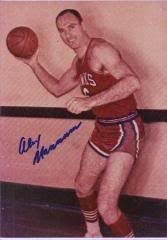
Alex Hannum
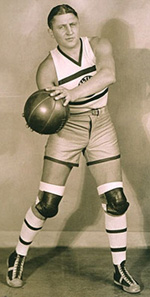
Dutch Dehnert
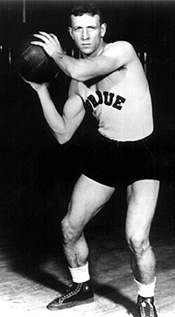
John Wooden
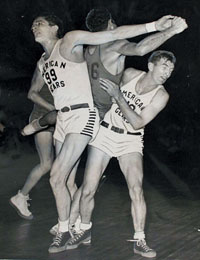
George Mikan (99) with Chicago American Gears
|
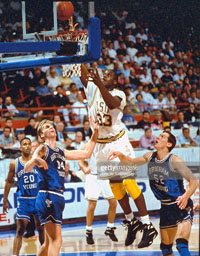
Shaquille O'Neal vs Brigham Young
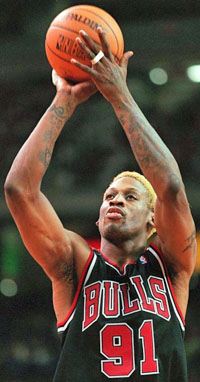
Dennis Rodman
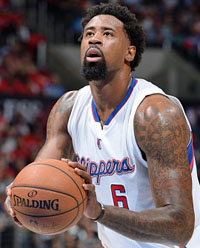
DeAndre Jordan
|
When Shaquille O'Neal played for LSU, opponents who were trailing the Tigers adopted a strategy calculated to eat into the lead.
Shaq's college FT shooting looked like this.
| Year |
FTA |
FT |
FT% |
| 1989-90 |
153 |
85 |
55.6 |
| 1990-91 |
235 |
150 |
63.8 |
| 1991-92 |
254 |
134 |
52.8 |
The strategy was illustrated by contrast as LSU prepared to play Brigham Young in the first round of the NCAA Tournament during Shaq's junior year.
- Cougars coach Roger Reid announced that his club would not pay any special attention to O'Neal but instead "defense LSU as a team."
- LSU F Vernel Singleton said, Nobody's tried that before. That's a brave approach. ... It may take us awhile to get used to it. ... I know Shaq will appreciate it.
- Coach Dale Brown was more direct. Everybody we play uses the defense that's been invented especially for Shaquille. It's called the intentional foul defense. Opposing coaches, on the theory that he can't hurt you nearly as much on the line as he can with a dunk, instructed players to foul O'Neal as soon as he got the ball. That approach so incensed Brown that he advised Shaq to forego his senior season at LSU and join the NBA. Until they change the rules and eject people who foul intentionally, my recommendation will be that he leaves. I'd dearly love to have him back, but I have to put my emotions aside. It's just not right. At least I can sleep nights.
- BYU did not employ the intentional fouling strategy until the last minute of the game. The Tigers hit 11 of 12 FTs in the final 2:35 to salt away the 94-83 victory.
- O'Neal did indeed go pro at the end of the season.
- However, the name "Hack-a-Shaq" ploy was not invented at the time.
The intentional fouling strategy was resurrected in 1997 by Don Nelson, coach of the Dallas Mavericks.
- If an opponent had an especially bad FT shooter, Nelson theorized, why not foul him repeatedly throughout the game? That would shorten the opponent's possessions and also reduce their points-per-possession average. To avoid fouling out one of his frontline players, Nelson employed the strategy at selective times by substituting a little-used player to commit the intentional foul.
- One of the players Nelson targeted for fouling was Dennis Rodman of the Chicago Bulls. Another of Nelson's targets was Shaquille O'Neal.
- Coach Gregg Popovich of the San Antonio Spurs applied the strategy in Game 5 of the first round of the playoffs against O'Neal and the Phoenix Suns in 2008. Pop's intention was to eliminate 3-point attempts. He also applied the strategy in the last 25 seconds of each quarter to get the ball back for a last shot. The Spurs won 92-87 to win the series. ESPN. com columnist John Hollinger dubbed the strategy "Hack-a-Shaq."
Hack-a-Shaq still plagued the NBA during the 2015-16 season.
- Clippers C DeAndre Jordan, Pistons C Andre Drummond, and Rockets C Dwight Howard accounted for 69% of Hack-a-Shaq fouls.
- Commissioner Adam Silver had remained indifferent on the strategy during his first two years in the job.
- But putrid foul shooting (which encouraged Hack-a-Shaq), lengthy games, and fan discontent finally convinced him that a rule change was needed.
- Silver: Even for those who had not wanted to make the change, we're being forced to that position just based on these sophisticated coaches understandably using every tactic available to them. It's just not the way we want to see the game played. ... As I travel around the league, there's that one school of thought. "Guys have got to make their free throws." But then at the end of the day, we are an entertainment property, and it's clear that when you're in the arena, that fans are looking at me, shrugging their shoulders with that look saying, "Aren't you going to do something about this?"A
It will be interesting to see if any change is made for the 2016-17 season.
|
Shipley Integrates USL - I
The first all-white university in the South to accept undergraduate African-American students was Southwestern Louisiana Institute (now Louisiana-Lafayette) in 1954. Three years later, Beryl Shipley took over as head basketball coach for the Bulldogs (the school's nickname at the time). He thus embarked on a roller coaster ride that would bring the school success on the court but bring him into conflict with the school administration, state agencies, and the NCAA.
- In Shipley's first year, attendance ranged from 500 to 750. The status of basketball was such that the team had to vacate Blackham Coliseum multiple times during the season to make way for a flower show, a rodeo, or a dog show.
- Still, Beryl's first squad finished with a 16-11 record to end five straight losing seasons at SLI.
- As a result, Shipley earned Coach of the Year honors in the Gulf States Conference.
- He won the honor again in 1958-9 with a 15-9 record.
- Shipley succeeded because he drove his players relentlessly. They responded because he was honest and consistent in his dealings with his all-white squad. Like any good coach, he meticulously prepared his team for each game. They might lose to teams with superior talent, but it wouldn't be because of weak fundamentals or lack of conditioning.
Shipley got a foretaste of future problems at the university when he inaugurated the Bayou Classic, a Christmas holiday tournament.
- The first tournament was scheduled for December 1959. The coaching staff had lined up three teams: Mississippi Southern (now USM), North Texas State, and Stetson.
- Shipley guaranteed each team's travel and accomodations as well as a banquet for the teams and gifts for the coaches. The cost to USL (as the school was now called) would be $800, an amount expected to be covered by the gate receipts with room to spare.
- In mid-November, the university president, Dr. Joel Fletcher, ordered Shipley to cancel the tournament because it was too expensive.
- Beryl responded by turning to the supporters he had developed in the Lafayette area. They underwrote the tournament because it brought visitors to the city and made it a success throughout its 14-year life span.
- Still, Fletcher would not forget Shipley's end run around his order. The president would bide his time before striking back.
- The resentment Fletcher's administration felt toward the coach simmered even more when the major of Lafayette proclaimed Saturday, February 18, 1961 as Coach Beryl Shipley Day. He read the official proclamation in ceremonies before the USL-McNeese State game at the Coliseum. Among the points cited were the #11 ranking in the latest small-college poll, 19 straight home wins, and Shipley's building USL basketball into "a booming business."
Shipley built the program until the 1964-5 team achieved another milestone.
- Led by All-American G Dean Church, the Bulldogs compiled a 17-9 record to qualify for a regional berth in the NAIA national tournament.
- Shipley's joy was tempered by anxiety. If USL won the regional, the administration might not allow them to participate in the tournament in Kansas City because opponents would include black athletes. State Board of Education policy barred state schools from competing against integrated teams.
- AD "Whitey" Urban assured Shipley that, if USL won the regional, the team would be allowed to participate. "You coach the basketball team; I'll handle the politics," Whitey told him.
- So Shipley entered a successful bid to host the four-team tournament, which included three more all-white teams from Alabama.
- Spurred by raucous crowds, USL defeated Troy State 92-86 and Huntingdon College 78-69 to earn District 27's spot in KC.
The next day, Fletcher struck.
- Shipley and his assistant were in the basketball office planning practices and the trip to KC when a reporter phoned to ask if they had heard the news.
- The president had informed the media without telling his coach first that the school would not participate in the NAIA Tournament. Fletcher didn't explain the reason, but everyone assumed it was pressure from the state board to maintain its anti-integration policy.
- In shock, Beryl drove to Urban's home after he couldn't get him on the phone. He found Whitey leaving town. The AD told the coach to accept the situation and say nothing to the press or anyone else. Don't make waves.
- Shipley hurried to the dorm where the upset players had gathered, some crying. The coach explained that he had learned of the decision as they had - from reporters. He suggested they form a group of students and go to the president's house to demand an explanation.
- When hundreds of students gathered in front his house, Fletcher refused to come out but finally agreed to meet with them at 8 am at the administration building.
|

Coach Beryl Shipley

Dr. Joel Fletcher

AD Whitey Urban
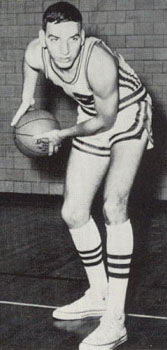
All-American G Dean Church
|
Fletcher spoke to the students the next morning.
- At a time when anti-Vietnam War protests were common on college campuses, his first words were, "Are you from Moscow? I do not deal with mobs. I'll deal with your leaders. Now go on to your classes."
- A voice shouted, "We're not going to leave until we find out why we can't go to Kansas City."
- Fletcher replied, "There'll be no negotiations until you disperse." Another student hollered, "We want to know why, that's all."
- Fletcher then surprised everyone: "If I had known this action would develop, I would not have made the telephone call I did an hour ago. At that time, I called the state board and told them I'm assuming full responsibility for sending the team to Kansas City. They're going."
- Contacted by the press, the chairman of the State Board of Education W. E. Whetstone of Monroe, denied telling Fletcher that USL could not to go to KC. Instead, he spun the situation to his advantage by saying he did not realize how much interested there was in Bulldog basketball. "I think it would have been detrimental to the state not to let USL play in the tournament."
Three days later, USL played heavily-favored Southern Colorado in the Municipal Auditorium in the first round of the NAIA National Tournament.
- The Bulldogs prevailed 66-59 with the support of the band and an enthusiastic student contingent. Afterwards, an SCU player said they had never faced a team that played such solid D.
- After USL lost its next game to Oklahoma Baptist 95-82, the Lafayette Advertiser article said: "The fact that the Bulldogs got beat wasn't really the important thing, although no one likes to lose. The important thing was that the Bulldogs got to come because of the finest student and town support in the history of the institution. This marked the first time that Lafayette and the Southwestern students really ever got behind a USL team."
Shipley's team had broken the "unwritten law" of Louisiana and other southern states by playing against two teams that included black players. His insolence would come back to haunt him.
USL Starting Five 1964-5
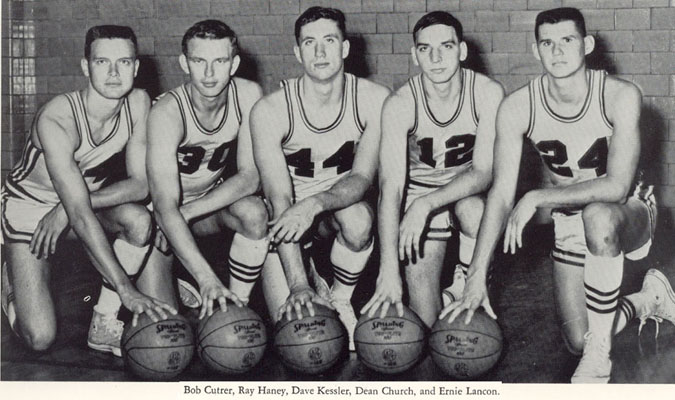
Reference: Slam Dunked: The NCAA's Shameful Reaction to Athletic Integration in the Deep South,
Ron Gomez with Beryl Shipley | Back to Top
|
|
Shipley Integrates USL - II
The University of Southwestern Louisiana Bulldogs had defied the State Board of Education and played in the 1965 NAIA National Tournament against teams with black players.
- Seeds of discord were sown that would be reaped many years later.
- Dr. Joel Fletcher, USL president for 25 years, unexpectedly retired shortly after he defied the state board and approved the team's participation in the NAIA tournament.
- Dr. Clyde Rougeau succeeded Fletcher.
Coach Beryl Shipley's 1965-6 team repeated as Gulf State Conference champions to again qualify for the NAIA regional tournament. However, they lost in the first round to end any discussion about whether they would be allowed to participate in the national tourney.
A little later that spring, an historic event forever changed college basketball.
- Don Haskins' Texas Western Miners (now UTEP) won the national championship with an all-black starting lineup.
- To add to the impact of the milestone, the Finals victory came over the Kentucky Wildcats of Adolph Rupp. Although coaching at the northermost SEC school, Rupp steadfastly maintained an all-white team, believing that black players didn't have the intelligence and work ethic to succeed in major college basketball.
With USL having had hundreds of black students since the mid-50s, Shipley, a native of Kingsport TN, decided that the time was right to recruit black players.
- Shipley related his plans to the new president, Dr. Rougeau, and received his approval.
- Accordingly, three black basketball players enrolled at USL for the fall semester of 1966.
- Elvin Ivory, 6'7" leaper from Birmingham AL
- Marvin Winkler, shooting G from Indianapolis IN who had broken the high school scoring records of the legendary Oscar Robertson
- Leslie Scott, another quick G from McKinley High School in Baton Rouge
When word spread, the leadership of the other state colleges and the State Board of Education reacted with resentment.
- The Board hastily arranged a meeting with Rougeau and Shipley.
- When asked how the black players got to USL, Shipley decided to protect Rougeau and instead told the board that the NAACP had sent the players. This white lie undoubtedly hurt the coach's cause because, in the climate of the times, the political leadership of states in the Deep South, led by Governor George Wallace of Alabama, were particularly enraged by "outside agitators" stirring up trouble.
- The board's new Commissioner of Athletics, Stanley Galloway, recently retired from a successful tenure as football coach at Southeastern Louisiana, told Rougeau: "You're the president; flunk the black students on entrance requirements."
- Rougeau replied that he couldn't do that because the students had satisfied the rules for admission to the university.
- Galloway then suggested Shipley start practice a week early and make sure the black players didn't make the team. The commissioner thus ordered the basketball coach to violate the NCAA rule that forbade organized practices before October 15.
- Shipley obeyed the order to start practice early, doing so on October 7 with the gym doors closed. However, he had no intention of running off the black players, two of whom had been high school All-Americans.
|
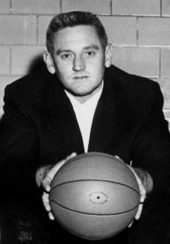
Coach Beryl Shipley
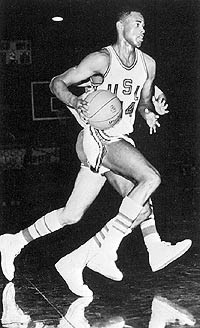
Elvin Ivory
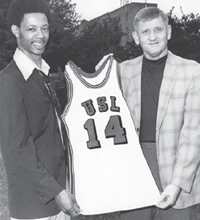
Marvin Winkler with Coach Shipley
|
The state board also attacked Shipley's integration plan on another front.
- The board informed USL that no scholarship funds would be available for the black athletes.
- When no arguments could dissuade the board from its blatantly racist policy, Shipley sought help elsewhere.
- He formed the Lafayette Business League to raise money from the Lafayette community, black and white.
- Beryl had the treasurer of the League deposit the funds directly with the business office of the university. The money was donated to pay for tuition, books, and other expenses that normally would be covered by a student's athletic scholarship.
- By ignoring Galloway's order to run off the black players and by circumventing the board to pay for scholarships, Shipley had widened his circle of enemies. They would exact their revenge in spades down the road.
Shipley crafted a challenging schedule to showcase his 1966-7 team, which was not only the first integrated college team in Louisiana history but the first in the entire Deep South.
- Beryl recalled: "We started the season with eight games, all played away from home, and we played them in fifteen days: North Texas State, Tennessee, Vanderbilt, Louisville, Houston, Auburn, Northeast Louisiana State [now Louisiana-Monroe], and Baylor. We played the first game on December 1, played the last on December 15, and lost every game except one, Northeast Louisiana. We arrived back in Lafayette and played Lamar on the 17th."
- "Before we made that trip, our guys had begun to feel that we were pretty good. I had some reservations about how good we were, and I had scheduled those eight games for two reasons. First, I wanted to play some well-known, successful schools that we had never played before, and in order to do so, we had to go to their place; they had no reason or desire to come to ours. Second, I wanted to determine how good we really were. Well, we found out. After we got back, I told the guys, along with a few other choice things, that we had a lot of work to do. And there wasn't any argument."
The team also made some history and faced extra adversity on the road throughout the season.
- Ivory, Winkler, and Scott were the first African-Americans to play at Auburn.
- When the team played at Louisiana schools, they arrived by bus the day of the game and left immediately afterwards, not even staying to shower. A police escort ushered them into and out of the gym to avoid any trouble.
- On January 7 at Nicholls State in Thibodaux, the team heard some racial taunting from the crowd.
The next trip, to Louisiana College at Pineville in north central LA, proved to be scarier.
- Students four and five deep lined both sides of the sidewalk as the team moved from the bus to the arena. "Gator bait, Gator bait!" was the chant even though the Baptist school's nickname was not Gators. In the dressing room, Shipley told his players not to react to anything the crowd did or said. "Just play your game. Show 'em what you can do with a basketball."
- When the Bulldogs came out for warmups, the pep band played "Dixie" while the crowd chanted "Gator bait!" That combination continued throughout the contest.
- After Ivory put on a slam-dunk exhibition to spark the 89-80 victory, ULL got out of town as fast as possible.
The Pineville scene was repeated a short time later a little further north, at Louisiana Tech in Ruston.
- Police cars with flashing lights met the team bus on the outskirts of town and escorted it to the campus.
- Armed officers lined the walkway into the field house to protect the team from the students.
- The black USL players were the object of constant hissing, booing, and taunting as well as very physical play. Officiating was "controversial," at best.
- Tech won 80-78 to sweep the home-and-home series. It would be the last time any team would defeat a Shipley-coached team twice in the same season.
The Bulldogs finished 20-11 to earn another invitation to the NAIA post-season tournament. They made it to the third round of the National Tournament in Kansas City before Oklahoma Baptist, the same team that had eliminated them two years earlier, knocked them out again, this time by only one point.
|
|
Shipley Integrates USL - III
Coach Beryl Shipley's USL Bulldogs won the championship of the Gulf States Conference the last two years the school participated in that league.
- The 1967-8 squad finished 19-5 with an 11-1 conference record. Non-conference victims included North Texas State, Baylor, Lamar, Pepperdine, and Creighton. They lost by one point at Oklahoma.
- The last GSC year produced a better team although the 20-7 record doesn't show it. Five losses came on the road at Michigan State, TCU, West Texas State, UTEP, and Hawaii. On the other side of the ledger, USL beat UNLV, Auburn, and Arizona State on the opponent's floor while Mississippi State and Baylor fell in the annual Bayou Classic in Lafayette.
1969-70, a transition year from NAIA to NCAA participation, brought Shipley's most ambitious schedule.
- The season began with three road losses to Houston, St. Louis, and DePaul. TCU fell 83-70 in the first home game. Arkansas and SMU also suffered defeat in Cajunland.
- The highlight of the campaign was a trip to Hawaii for back-to-back victories February 20-21.
- The final mark was 16-11.
Marvin Winkler departed after the '69-70 season with 2,128 points and 580 assists.
- At that time, he was the leading scorer in school history.
- He still ranks third in career points behind Bo Lamar (1970-73) and Andrew Toney (1977-80).
- During his only season in the NBA, Winkler joined the Milwaukee Bucks late in the 1970-1 campaign in time to be on the championship team. He played the next year with Indiana in the ABA.
|
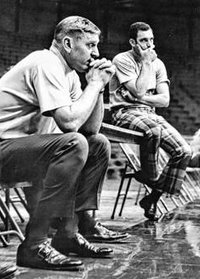
Coach Beryl Shipley and
Assistant Ron Cox
|
 Marvin Wnkler is third from left in the second row. Kareem Abdul-Jabbar is #33; Oscar Robertson is #1.
Marvin Wnkler is third from left in the second row. Kareem Abdul-Jabbar is #33; Oscar Robertson is #1. |
In 1970-1, USL continued in the NCAA "College Division" (Division II today) as an independent.
- Shipley adapted his coaching to the players. Early in his career, he ran the "shuffle" O with constant motion and many passes. With faster, more talented players, he switched to a fast-break O and a "trap zone" D.
- With Dwight "Bo" Lamar from Columbus OH leading the way, the team broke the century mark ten times, including the first three games of the season - Oral Roberts (124-114), Dillard in New Orleans (108-81), and Southern (115-93).
- Notable victories included Oklahoma State 88-71 in the finals of the Bayou Classic and UTEP twice in El Paso.
- On February 25 against Northeast Louisiana at Blackham Coliseum, Lamar scored 62 points as he single-handedly brought the Cajuns back from a six point deficit with 35 seconds left to tie and win in OT 107-104. Bo led the College Division in scoring that season with a 36.0 average.
The most interesting game of the season was played in Natchitoches against old GSC rival Northwestern State.
- The Demons' head coach, Tynes Hildebrand, openly criticized USL's recruitment of black players and was determined to slow down "Shipley's Flying Circus."
- He ordered his all-white team to sit on the ball. With no shot clock at that time, NSU's G crossed midcourt and stood and held the ball.
- At first, the Cajuns aggressively pressed but were called for fouls. So Shipley called timeout and told the team to drop back.
- Eventually, USL had to press the issue by stealing the ball or fouling. The Cajuns escaped with a 25-21 victory.
- An amusing incident occurred in the second half. Shipley, as usual, prowled the sidelines, yelling instructions and fussing at the officials. Suddenly, a referee blew his whistled and signaled a technical foul. Everyone assumed it was against Beryl but no - it was against sportswriter J.C. Hatcher of the Lafayette Advertiser sitting courtside! No one could understand how a technical could be credited to USL because of something a sportswriter said.
USL finished the regular season 21-3 to earn the right to host the NCAA College South Regional.
- They outscored UNO 113-107, then knocked off Tennessee State 86-82 before 11,000 fans (in the 8,500 capacity Blackham Coliseum) to earn a trip to the NCAA College Tournament in Evansville IN.
- They defeated Assumption 110-99 before losing to the host Evansville Aces 93-74.
- USL closed its 25-4 campaign by drilling Kentucky Wesleyan 105-83 in the consolation game.
USL joined the Southland Conference in NCAA Division I for the 1971-2 season.
|
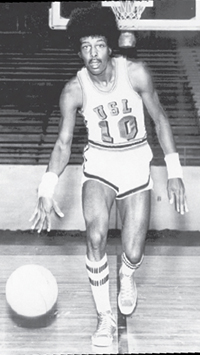
Dwight "Bo" Lamar
|
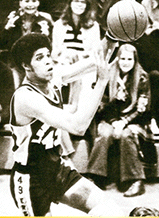
Ed Ratleff
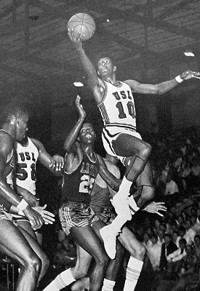
Dwight "Bo" Lamar
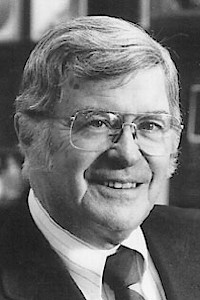
Walter Byers (in later life)
Top of Page
|
Shipley Integrates USL - IV
The University of Southwestern Louisiana Ragin' Cajuns joined the top tier of the NCAA for the 1971-2 season as members of the Southland Conference.
- After losing the opener at Eastern Kentucky, USL rattled off 13 straight wins, including triumphs over #7 Houston and Jerry Tarkanian's Long Beach State 49ers, which featured 6'6" Ed Ratleff, the high school teammate of Cajun star Bo Lamar.
- Included in the streak was a 107-86 hammering of Louisiana Tech, ranked #1 in the college division. USL also beat Scotty Robertson's club at Ruston three weeks later, 111-101.
- After a loss at Cal State - Los Angeles, Shipley's squad won another eight in a row before bowing at Cincinnati.
- The regular season ended with a 21-2 record and a perfect 8-0 in the Southland to earn an invite as conference champs to the NCAA Regional in Las Cruces NM. At that time, the NCAA Tournament consisted of only 24 teams.
- The Ragin's beat Marshall 112-101 to move to the Sweet Sixteen in Ames IA, where Louisville upended USL, 88-84. The season ended with a 100-70 walloping of Texas in the regional consolation game.
- Bo Lamar led the nation in scoring with a 36.3 average to become the only player ever (to this day) to lead both Division I and II in scoring.
Lamar's senior year, 1972-3, brought another great record, 23-3, another undefeated Southland season, and another appearance in the NCAA tournament.
- USL defeated a number of nationally-ranked teams along the way: UNLV, Marshall, Mercer, and Oral Roberts.
- The Cajuns finished Bo's three years with only one home defeat (93-90 to Baylor in 1970-1).
- In the postseason, USL defeated #7 Houston 102-89 in Uniondale NY. That moved them to the Sweet Sixteen again where they lost to Kansas State 66-63 in what was almost a home game for the Wildcats in Wichita. USL then lost to South Carolina in the consolation game 90-85.
Shipley's sensational three-year record of 75-13 would all be overturned by a chain of events that had actually begun in 1967.
- On January 20 of that year, the NCAA issued a seven-page, 58-item "official inquiry" into irregularities in the USL basketball program.
- It would later become known that the allegations originated from Gulf States Conference Commissioner/Louisiana Commissioner of Athletics Stanley Galloway, who had acted, George Wallace-style, as a one-man barricade against integration of Louisiana college athletics.
- One of the charges stated that USL had used an outside group to fund the scholarships of three black basketball players (Elvin Ivory, Marvin Winkler, and Leslie Scott). While factually correct, this allegation ignored the fact that the reason Coach Shipley had enlisted donations from Lafayette businesses to help the players was that the State Athletic Committee (consisting of Galloway alone) had ordered USL not to fund athletic scholarships for black athletes.
- The NCAA also charged Shipley with conducting an illegal practice prior to the approved starting date. As the coach himself explained in a lengthy letter to NCAA Executive Director Walter Byers:
The early practice was called at the instructions of the Gulf States Conference Commissioner. He insisted that the practice be held prior to the beginning of the season, and that any Negro athletes interested in trying out for the USL squad should be asked to attend and that following that early practice, I should then refuse any of these athletes for scholarship - either on the ground that they had failed to pass the NCAA approved examination, or that they were not good enough to make the team. I specifically informed Mr. Galloway that I knew this was a violation of the NCAA rules but he in turn stated that it was O.K. and that he would accept full responsibility for the early workouts.
- Byers did not even acknowledge receipt of Shipley's letter. Rushing to judgement, the NCAA placed USL on two-year probation and banned them from post-season activities for the 1967-8 and 1968-9 seasons.
- Shipley resented not only the punishment but also the fact that the school administration, and specifically President Clyde Rougeau, did not vigorously defend the program and undertake an appeal of the NCAA penalties. Rougeau was caught between a rock and a hard place, trying to respond to the NCAA charges without revealing the racist instructions USL received from his superiors, the State Board of Education.
The 1968 penalties proved to be the preliminary punch for the NCAA's knockout clout of 1973.
|
Shipley Integrates USL - V
In early November 1972, the NCAA sent a letter to the USL administration containing 32 pages of alleged violations of NCAA rules by the basketball program. Coach Beryl Shipley received only the letter accompanying the allegations. Not until 2006 did he finally see all the documents produced by the investigation.
- The investigation began in July 1970 and continued until September 1972. At no time did NCAA investigators interview Shipley or his assistant, Tom Cox, to get their response to any allegations against them.
- The NCAA gave the university only until December 13, 1972, to respond to the allegations.
- USL requested an extension and was given until March 1but still had to send represenatives to a meeting of the NCAA council on December 19, at which the findings of the investigation would be presented. In other words, the investigators were presenting their results before USL had an opportunity to respond to the allegations.
The charges were grouped under three major areas.
- Recruiting
- $15-20 was provided to recruits who were visiting campus.
- The university paid for two plane trips to the campus for each of two recruits.
- The athletic department provided automobile transportation to and from a job site to a prospective athlete.
- Eligibility
- Surrogates took the ACT exam in place of recruits.
- Incorrect GPAs were used to predict that two recruits would make the 1.6 GPA that the NCAA required of athletes.
- A recruit's high school transcript was altered to improve his GPA.
- Scholarships were provided to two athletes who had not completed the necessary procedures the university required for predicting the 1.6 needed to qualify for aid.
- Providing Aid to Student Athletes
- Athletes were loaned private autos for dates.
- Gasoline was provided for athletes to allow them to drive their own cars to and fro practice sessions held away from the main campus.
- Loans were made to athletes.
- Automobile transportation was provided athletes returning to campus after a school break.
It turned out that almost all the accusations came from a graduate assistant, Harry Garverick, whom Shipley had dismissed two years earlier, and a player that Gaverick recruited, Frank Kluz, whom Shipley also ran off.
After a perfunctory investigation at best, the USL president, Dr. Claude Rougeau, sent a response to the NCAA that implied that the accusations were true.
- This was done without even giving Shipley or his assistant Cox the courtesy of reading the allegations.
- Nor were any of the implicated athletes interviewed.
Since the administration didn't seem to want to counter the NCAA accusations, a group of private individuals volunteered their help.
- The committee included state Senator "Sonny" Mouton, an attorney, as well as several other lawyers.
- Their investigation produced information that would counter almost every charge.
In the meantime, the NCAA council held its hearing on December 19, 1972.
- The three USL representatives explained that they had not had sufficient time to formulate a defense. They requested that the NCAA allow the university to respond on the previously agreed upon date of March 1, 1973.
- After the hearing, the volunteer lawyers obtained a preliminary injunction from a Louisiana judge enjoining the NCAA from proceeding further until the university had sufficient time to respond to the charges.
The case dragged on through the spring. Since no final decision had been rendered by the association, USL played in the NCAA basketball tournament.
- The Ragin' Cajuns beat Houston 102-89 at Ames IA.
- Kansas State eliminated USL 66-63 in what would turn out to be the last college game Beryl Shipley ever coached.
Dr. Ray Authement, acting as USL President after Rougeau resigned, finally sent a comprehensive response to the NCAA on June 25, 1973.
- It included the lengthy report of the lawyers committee that successful countered most - but not all - of the NCAA's charges.
- However, the NCAA Committee on Infractions presented its final report to the NCAA council a little more than two weeks after receiving the USL response. There is little likelihood that the staff paid any attention to the university's 312-page final response.
- The 45-page infractions report was virtually unchanged from the original allegations presented the previous November.
After receiving the report, the Infractions Committee on August 4 enacted the most extensive punishment ever levied on a basketball program.
- USL's NCAA membership was terminated.
- The basketball program was suspended from competition for two years - the so-called "death penalty."
- All USL sports teams were banned from post-season play and TV appearances for four years.
In May, 1973, several months prior to the NCAA penalties, Shipley resigned after 16 years at USL, a 296-129 record, and only one losing season.
- Beryl spent the rest of his life trying to clear his name.
- He said that, if he broke any rules, it was only for "humanitarian reasons."
- Shipley finally responded in a 2007 book written by Ron Gomez, the broadcaster who called USL games.
Final note: During the months that this series of articles has been published on this website, Beryl Shipley passed away on April 15, 2011. Then the May 2, 2011, issue of Sports Illustrated published the article cited below.
References: Slam Dunked, Ron Gomez with Beryl Shipley (2007)
"An Accidental Hero," John Ed Bradley, Sports Illustrated, May 2, 2011
Click here for more information on Coach Shipley
|
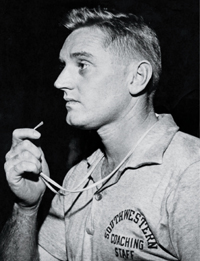
Young Beryl Shipley
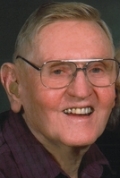
Old Beryl Shipley
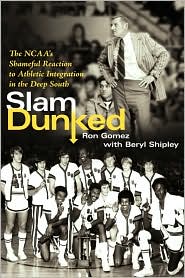
|
|
|